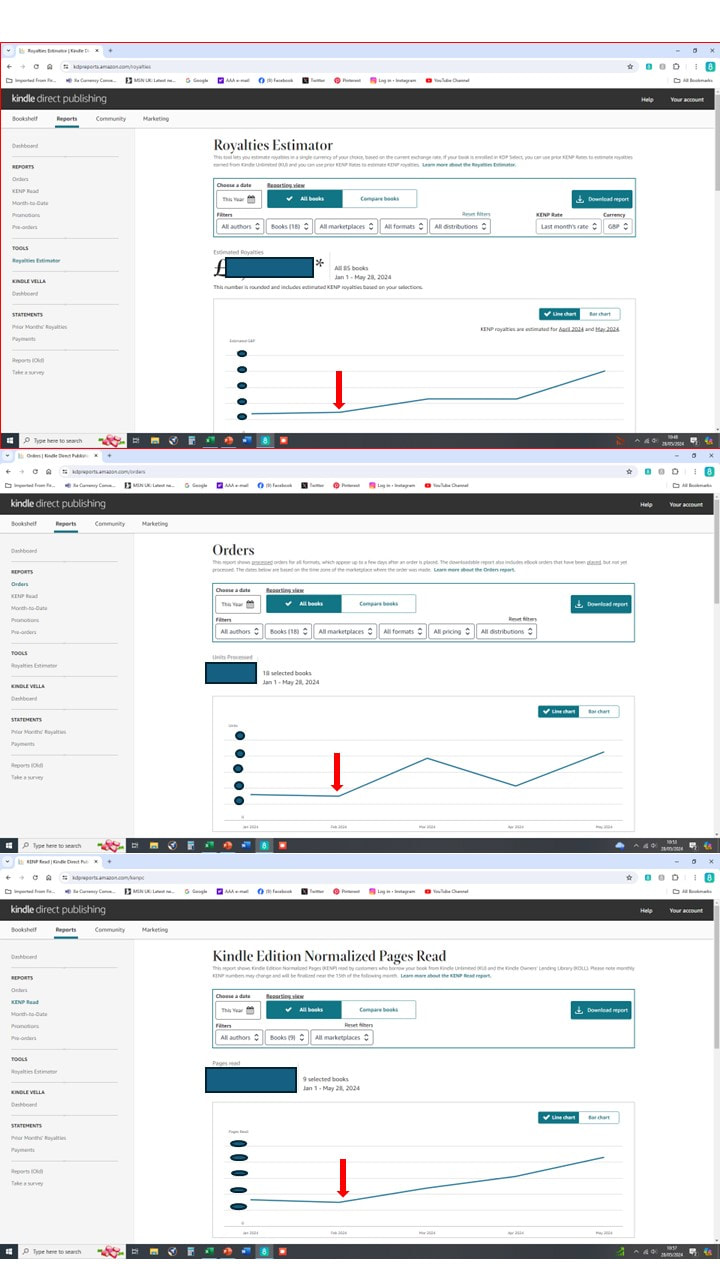|
We very rarely recommend products on this blog, so when we do you can be sure of two things. (1) We haven’t been paid to make the recommendation and (2) the product we are recommending has been of some tangible benefit to us.  This is the case with “Meta Ads Mastery for Authors”, a training course provided by Matthew J Holmes. To prove that it works, later in the blog we have posted a graphic showing the increase in Amazon sales we experienced over a 90 day period, for just one of the series of books we publish. Now for our upfront warning. This isn’t a “magic bullet”. It is not going to turn you into a bestselling author overnight. It will take time to learn the strategy and to refine it to make it work for your books. It will also involve some financial risk taking. Most importantly, it can’t turn a bad book into a bestseller (nothing can do that). BUT, if you stick with it, you will get results and those results are going to repay your investment.  Now, fair warning, for Indie authors adopting this strategy - it requires strong nerves. The financial outlay is far higher than we have had to make when we have tried out other marketing tools. It is also quite time consuming both in terms of working through the training materials and then trying out the lessons learnt. But as the old saying goes “You have to speculate to accumulate” and speculation, by its very nature, is risky and not for the faint hearted. However, we wouldn’t be recommending this product if the lessons it teaches didn’t work and here is the proof. We paid for the product on 2nd March 2024 and started to implement the early lessons on 4th March. The graphic below shows results for first 5 months of the year. The red arrow on the graphic shows where we started to use this new strategy (sorry we’ve redacted the actual royalties and sales data, but that is commercially sensitive information). In terms of orders, you can see a dip in month 2 of our experimental period. That is because the orders for month 1 were skewed by a 99p promotion that ran for 7 days. When the orders for that are discounted, the peak for month 1 is much lower, so the overall upward trend is more visible.. To assess whether our ad campaigns were successful or not we have used a calculation called “Return On Advertising Spend” (ROAS) which Matthew teaches in his course.  Essentially, this is the amount of royalties we received divided by the amount of money we spent on advertising, which gives us a number. If the number is greater than 1, our ads earned us more money than they cost. If they are less than 1, they cost us more than we made. We have included some of the cost of purchasing Matthew’s course in the ROAS calculation, as that is part of our costs. We decided to allow 12 months to recoup the cost, so we allotted 3 months’ worth of recovery to the ROAS calculation. Our ROAS for the 90 day period was 1.2 which means we made £1.20 in royalties for every £1 we spent on advertising. While that may not sound every exciting, when you scale that up to the hundreds or even thousands of pounds, the profit actually starts to look very impressive.  We also saw a considerable increase in KENP reads (KundleUnlimited (KU) downloads) during the same period, taking us from around 30% of total income to over 50% of the total. That means our ads reached a lot of KU subscribers. The book we were advertising is Book 1 of a series. We saw an up-tick in the numbers of sales we were getting for Books 2 to 9 during our 90 day experimental period, but some downstream sales won’t appear for several weeks yet, so we have to take them into consideration, but we haven’t factored them into our ROAS calculation because we don’t want to count our chickens before they are hatched.  An unexpected bonus during this period was for increased sales of the audiobooks for the series, of which there are 3 so far. During the 3 month testing period, sales surged to exceed the total for the financial year 22/23 and 23/24/ They now make up 40% of the lifetime total for the 3 books. While the sales link took the Facebook users to Amazon, it appears that listeners to audiobooks saw the ads and went looking for the audiobooks on their preferred sites. But there is no doubt that there is a large financial risk to using this strategy and that risk may not be acceptable for some authors, even though we are able to demonstrate through our own experience that the risk is reasonably low. Which is fair enough. It’s your money so it is you that is taking the risk. But we took the risk so you didn’t have to (you’re welcome).. Matthew does explain that you can spend less each day on your advertising, but that means it will take longer to achieve meaningful results. At the end of the day, it is up to you how much risk you are prepared to take in order to benefit from the sort of rewards that we have shown in our graphic. If that hasn’t convinced you that the product is worth the investment, then nothing will, so thank you for reading this far and we’ll see you next week for our next blog. For those that are still making up their minds, please read on for the rest of the product review.  What the course teaches you. The first thing you are taught is that an ad can’t sell your book. Your book has to sell your book. In other words, a Facebook Ad may get a click that takes a reader to Amazon (or wherever you sell your books), but if all isn’t right with your product page then the click won’t convert to a sale. Matthew recommends running your trial ads on a book that is already selling, so that you can be reasonably confident that your product page is OK, thus removing any confusing “noise” (my word). So, if your book isn’t currently making any sales, despite all your marketing efforts, look at the cover, the blurb, the free sample and the reviews. The barrier to sales is probably one of those 4 things (or maybe all 4). Fix that before you do anything else.  Whether you are new to Facebook Ads or not, the course aims to teach you a new strategy for using the platform for advertising, some of which may go against what you have been taught in the past. It provides tools and techniques both to improve your audience targeting, so you get more bangs for your advertising buck and also identifies better ways of creating ads so that they are more appealing to Facebook’s users. It also takes you into parts of the Meta platform that you may not have entered before, so there is a lot to be learnt.  One of the expressions Matthew uses is “stop the scroll” (which we blogged about in April). In other words, create ads that stop people from scrolling past them, which is the first battle to win for any advertising campaign on any platform. If your “creative” (the combined image, headline and text) doesn’t stop people scrolling, you won’t sell any books. Matthew recommends you run your trials over a 90 day period. This allows you enough time to create a variety of different ads to learn from them, to find out which techniques work best for your book(s), what sort of images work best, what sort of text etc. And those things will vary from genre to genre (its why we are only writing this review now, when we bought the product in March). That doesn’t mean you have to wait 90 days to see any results (as we have shown), only that you will start to get the best results after you have been learning for around 90 days. From experience, however, we suggest that by the time you get to the end of the first 30 days you will be earning enough to finance your experimentation during days 31 to 90.  One of the things the course focuses on is relating your ad “creative” to your sales so that you can learn from your ad’s performance. Facebook is very good at spending your money. They will show your ad to as many people as possible in order to get as many clicks as they can so they can spend your budget. However, not every ad you post is going to perform equally in terms of clicks. Some ads will get you more clicks than others and it is important that you know which are working hardest for you. You will want to “scale” a good performing ad (ie spend more money on it) so it sells you even more books and you will want to turn off poor performing ads so you don’t waste money on them. All of that is discussed during the course. In addition, you will want to identify the type of creative that is getting you the best results so that you can create similar ads and try them out. Image A may look good to you, but image B may get you more clicks because the people who see it like it better. The same applies to text and headlines. Finding out this sort of thing is gold dust in advertising terms.  The course talks a lot about how you analyse your data so that you can both scale the ads that work and to identify the sorts of creative that works best for your genre. Different genres attract different readers who are attracted by different creative styles. For some people this will seem scary. For some people, data is something that someone else analyses and the thought of analysing their own data may scare the pants off them. However, listen to what is being said, because there are valuable lessons to be learnt. You may not have either the time nor the inclination to try everything that is taught, but the more you try, the more you learn about your ads and the better you can become at creating and running them. While the course may generate sales wherever you sell your book, it works best with Amazon. That is because using something called “Amazon Attribution” (taught as part of the course) you can track sales generated from your FB ads directly. That means you get the clearest indication of which ads are working and which aren’t. That isn’t possible for other publishing platforms or from your personal website. You can track how many clicks you get that take people to other platforms, but you can’t track how many of those clicks are converted to sales. While you may get sales, you won’t know if they are ”organic” or if they have originated with FB ads. That isn’t a problem with the course, it is a problem with the way sales can be tracked on those other platforms.  As we have said, the strategy works, which is why we have given it a very rare (for us) 5 star rating. Investing the time to learn it is going to benefit your book sales and it really does deliver improved sales. If it didn’t, I wouldn’t have expended so many words on telling you about the product. Overall, we here at Selfishgenie Publishing are pleased to recommend “Meta Ads Mastery for Authors” and you can find out more about the product here. If you have enjoyed this blog, or found it informative, then make sure you don’t miss future editions. Just click on the button below to sign up for our newsletter. We’ll even send you a free ebook for doing so.
0 Comments
Leave a Reply. |
AuthorThis blog is compiled and curated by the Selfishgenie publishing team. Archives
June 2025
|


 RSS Feed
RSS Feed